#RightsofWife
Explore tagged Tumblr posts
Text
Streedhan Laws In India: All You Need to Know

This article on 'Streedhan Laws In India: All You Need to Know' was written by an intern at Legal Upanishad.
Introduction
In India, women's rights and empowerment have become crucial areas of focus in recent years. One aspect of this movement is the protection of streedhan, a concept deeply rooted in Indian culture and traditions. Streedhan refers to the wealth, gifts, or property that a woman receives from her parents, relatives, or in-laws during her marriage. These gifts are meant to provide financial security and independence to the woman, and they hold significant cultural and emotional value. However, despite its importance, streedhan is often subjected to disputes, mistreatment, or even outright denial of ownership. To address these issues, India has implemented specific laws and regulations known as streedhan laws. These laws aim to protect women's rights regarding the streedhan they receive and ensure their empowerment within the institution of marriage. This article delves into the comprehensive understanding of streedhan laws in India, exploring their significance, key provisions, legal remedies, and recent developments.
Historical Context of Streedhan
Streedhan finds its roots in ancient Indian traditions and customs. Historically, women were given streedhan to provide them with financial security, enable them to maintain their own household, and ensure their independence. Streedhan often consisted of jewellery, land, cash, or other valuable assets. The concept reflected the belief that women deserved financial autonomy and were entitled to their own wealth, irrespective of their marital status. Over time, with changing social dynamics and patriarchal influences, the significance of streedhan has been undermined, leading to numerous disputes and exploitation. Recognizing the need to safeguard women's rights in relation to streedhan, the Indian legal system has implemented laws to ensure its protection and promote gender equality.
Legal Provisions for Streedhan
The legal framework surrounding streedhan in India is multi-faceted, encompassing several acts, sections, and judicial precedents. Understanding these provisions is crucial for women to assert their rights and seek appropriate legal remedies in case of disputes. Some key provisions include: - The Hindu Succession Act, 1956: The Hindu Succession Act, 1956 recognizes streedhan as a woman's absolute property. It ensures that a woman has the right to acquire, hold, and dispose of streedhan according to her wishes, independent of her husband or other family members. - Dowry Prohibition Act, 1961: Although streedhan and dowry are distinct, the Dowry Prohibition Act, 1961 plays a crucial role in streedhan-related disputes. The act prohibits the giving or taking of dowry and provides legal protection to women against dowry harassment, cruelty, or any demand for dowry. This act indirectly supports the protection of streedhan by discouraging the unlawful appropriation of a woman's wealth. - Protection of Women from Domestic Violence Act, 2005: The Protection of Women from Domestic Violence Act, 2005 recognizes the importance of streedhan and acknowledges it as a woman's right. It ensures that any denial of streedhan or harassment related to it can be addressed under the act. Women can seek protection orders, residence orders, monetary reliefs, and other legal remedies to safeguard their streedhan and secure their well-being. - Matrimonial Laws: Various matrimonial laws, such as the Hindu Marriage Act, the Muslim Personal Law, and the Special Marriage Act, also incorporate provisions to safeguard streedhan. These laws outline the rights and obligations of both spouses, ensuring that a woman's streedhan is not misappropriated or unduly controlled by her husband or in-laws.
Legal Remedies and Redressal
In cases where a woman's streedhan rights are violated, the legal system provides several avenues for seeking redressal. It is essential for women to be aware of these remedies to protect their streedhan effectively. Some common legal remedies include: - Filing a Police Complaint: If a woman faces harassment, mistreatment, or denial of streedhan, she can file a complaint with the police. It is crucial to gather and preserve evidence, such as photographs, receipts, or witnesses, to support the case. - Seeking Civil Remedies: Women can approach civil courts to seek specific reliefs such as injunctions, recovery of streedhan, or even compensation for the emotional distress caused due to the violation of their rights. - Initiating Legal Proceedings: Women can also file legal cases against their husbands or in-laws under relevant acts like the Hindu Succession Act, Dowry Prohibition Act, or the Protection of Women from Domestic Violence Act. These legal proceedings help ensure that the woman's rights are protected and her streedhan is rightfully returned. - Alternative Dispute Resolution Mechanisms: Mediation or arbitration can be used as alternative dispute resolution mechanisms to resolve streedhan disputes amicably. These processes provide a platform for dialogue and negotiation, promoting a fair settlement and reducing the burden on the judiciary.
Recent Developments and Challenges
In recent years, streedhan laws in India have witnessed significant developments aimed at strengthening women's rights. However, challenges persist in their effective implementation. Some noteworthy recent developments include: - Awareness Campaigns and Legal Aid: Government initiatives, NGOs, and legal aid organizations are working together to raise awareness about streedhan laws among women. These campaigns aim to empower women with knowledge about their rights and the legal recourse available to them in case of streedhan-related disputes. - Fast Track Courts and Timely Justice: To expedite streedhan-related cases, fast track courts have been established. These specialized courts focus on resolving cases related to women's rights, including those involving streedhan, within a shorter timeframe, ensuring timely justice. - Digital Documentation and Evidence: The use of digital documentation and evidence, such as photographs, videos, or online receipts, has become instrumental in streedhan disputes. Digital platforms provide secure ways to store and present evidence, strengthening the woman's case in legal proceedings. However, despite these positive developments, challenges persist. Lack of awareness, social stigmas, and complex legal procedures often deter women from seeking justice. Furthermore, cultural biases, delays in legal proceedings, and inadequate implementation of streedhan laws continue to impede effective redressal.
Suggestions
Awareness and Education: - Conduct widespread awareness campaigns to educate women about their rights regarding streedhan, emphasizing the importance of financial independence and empowerment. - Integrate streedhan laws into school curricula and conduct workshops and seminars to educate young girls about their rights and the legal recourse available to them. Legal Reforms: - Continuously review and update existing streedhan laws to address any gaps or loopholes that may be exploited. - Simplify legal procedures and make them more accessible, ensuring that women can easily navigate the system without facing unnecessary delays or financial burdens. - Consider the establishment of dedicated streedhan courts or special cells within existing courts to handle streedhan-related cases efficiently.
Conclusion
The streedhan laws in India play a vital role in protecting women's rights and promoting their empowerment within the institution of marriage. Recognizing the cultural and emotional value of streedhan, these laws provide a legal framework to safeguard women's ownership, independence, and financial security. Through various legal provisions, remedies, and recent developments, streedhan laws aim to address the challenges faced by women in asserting their rights. By raising awareness, facilitating legal aid, and expediting judicial processes, efforts are being made to create an environment where women can confidently protect their streedhan and secure their empowerment. However, to ensure the effective implementation of streedhan laws, continuous efforts are needed to eliminate social stigmas, enhance awareness, and streamline legal procedures. Empowering women with knowledge about their rights and facilitating accessible legal remedies will contribute to a society where streedhan is rightfully recognized, respected, and protected, fostering gender equality and women's empowerment in India.
References
- The Hindu Succession Act, 1956 - Dowry Prohibition Act, 1961 - Protection of Women from Domestic Violence Act, 2005 - “What Is Streedhan As Per Law? Is It Legal In India?” available at https://sahodar.in/what-is-streedhan-as-per-law-is-it-legal-in-india/ (Last visited on 08-06-2023) Read the full article
0 notes
Text
Maintenance of Widowed Daughter-in-Law
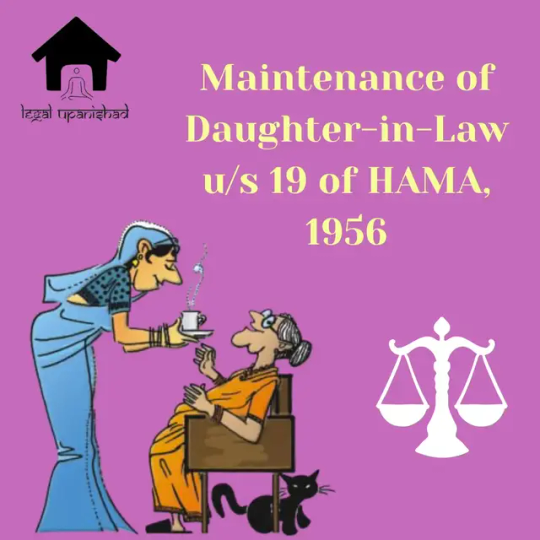
This article on 'Maintenance of Widowed Daughter-in-Law u/s 19 of Hindu Adoption and Maintenance Act' was written by an intern at Legal Upanishad.
Introduction
Maintenance fundamentally means support to someone who is unable to maintain and sustain herself or himself. Predominantly in India, women are not able to maintain and sustain themselves after the divorce or the death of a husband due to constraints and diminutions they face in society. This makes it harder for women to sustain themselves and looking at the constraints and restrictions women face parliament has passed a law regarding this. Hindu Adoption and Maintenance Act, 1956 which governs the law concerning maintenance. For this article, our concern would be the maintenance of the widowed daughter-in-law which is governed by Section 19 of the Hindu Adoption and Maintenance Act, 1956 (HAMA). Under section 19 of HAMA, the widowed Hindu wife is entitled to maintenance from her father-in-law to the extent that she is not able to sustain and maintain themselves from earnings or property.
Maintenance of Widowed Daughter-in-Law
Where the widowed daughter-in-law is unable to sustain and maintain themselves from her income or estate or has no estate of herself or is not able to secure maintenance from the property of her husband or her mother or father then she is entitled to the maintenance from her father-in-law under section 19(1) of HAMA. Nonetheless, section 19(2) of HAMA states that where the father-in-law has no means to provide maintenance to the widowed daughter-in-law from his property then the obligation stated under section 19(1) ceases to be enforceable. In addition, the widowed daughter-in-law's maintenance right would cease to exist after her remarriage. Right of Maintenance of Widowed Daughter-in-Law: Maintenance of the widowed daughter-in-law can be met up from the estate where the deceased husband had a share in the estate. To plead section 19 the deceased husband should have a share in the estate. In Raj Kishore Mishra v. Smt. Meena Mishra, the court decided that the father-in-law is under no obligation if he does not have sufficient means to provide maintenance through his coparcenary estate. It is crucial to note that the daughter-in-law would have no right to claim the ownership of the property self-acquired by the deceased husband's parents. In Satpal v. Suman and Ors. It was stated that maintenance of the widowed daughter-in-law from the salary of the father-in-law would be inconsistent with section 19(2) of the Act. As the husband has no share in the father's salary, the widowed wife would also have no share. Under the old Hindu law, an uncodified daughter-in-law had the right of maintenance against the self-acquired property of the father-in-law but it is important to consider that section 4 of the act which provides for a non-obstante clause would be having the overriding effect and the aforesaid rule would cease to exist subsequent to the enactment of the HAMA. Mother-in-law would not have any legal liability to support and provide finance for her daughter-in-law from her own estate or possessions. In Venubai v. Laxman Lahanuji Rambhad, the court stated that it is important to understand that section 19 is a whole scheme in itself laying down obligation and its enforceability, and sections 19(1) and 19(2) are not independent of each other. Under section 19 the daughter has a right that corresponds to the obligation of the father-in-law.
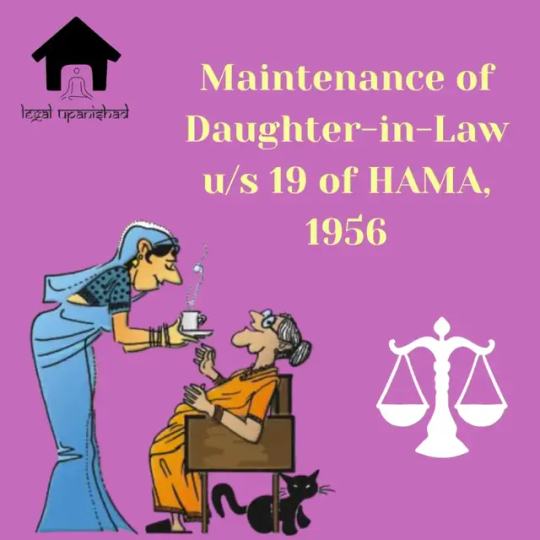
Maintenance of Widowed Daughter-in-Law
Maintenance of Minors with the Widowed Daughter-in-Law:
In a Hari Ram Hans v. Smt Deepali & Ors. judgment by Punjab and Haryana High Court, it was held that under section 19 of HAMA the word ‘widow’ would also include minor children living with her and are entitled to maintenance. In Smt. Raina v. Hari Mohan Budhaulia case the honorable Allahabad High Court held that the petitioner widowed daughter-in-law and her two minor daughters are also entitled to maintenance from her father-in-law as she had no means to maintain herself and her daughters and the father-in-law had the sufficient means to maintain her along with her two daughters. The high court also quashed the impugned order passed by the court below saying the court should not go into the provision's technicalities but consider the act's intention while enacted.
Section 19(2) of HAMA:
It is important to understand the scope and meaning of Section 19(2) as it mentions the coparcenary property in the ownership of the father-in-law through which he would be providing maintenance to his widowed daughter-in-law. In Nand Kishore Lal vs Shrimati Chanchala Lal, the court stated that the coparcenary property refers in the section would consist of ancestral property or joint acquisition. Sub-section (2) of Section 19 has the meaning that is only extended to the ancestral property.
Conclusion
Women's social and economic condition in Indian society is often fragile and weak due to the constraints and restrictions they face in an overwhelmingly patriarchal society. This makes women dependent and after the separation or the death of the husband, the women become unable to maintain themselves. Looking at the aforesaid situation the parliament has passed an appropriate law known as the Hindu Adoption and Maintenance Act, 1956 (HAMA) which governs the maintenance rights of a wife and widowed daughter-in-law. As Section 19 of HAMA further clarifies the stand of the law regarding the rights of maintenance of women. As the law protects and safeguards the interest of widowed women in a case where she is unable to sustain and maintain themselves after the death of their husband. In this course of events, it becomes obligatory for the father-in-law to provide maintenance to the widowed daughter-in-law and as well to the minor children thus they can sustain themselves.
Reference:
- Salil Tiwari, “Widow” Would Include Minor Grandchildren Staying With Mother: Punjab & Haryana HC, Law Beat, 7 January 2023, available at: https://lawbeat.in/news-updates/s-19-hindu-adoptions-maintenance-act-widow-would-include-minor-grandchildren-staying-mother-punjab-haryana-high-court#:~:text=Synopsis,ownearningsorotherproperty - Basit Amin Makhdoomi, Minor Children Of Widowed Daughter-In-Law Entitled To Maintenance U/S 19 Hindu Adoptions And Maintenance Act: Punjab & Haryana High Court, LiveLaw, 6 January 2023, available at: https://www.livelaw.in/news-updates/punjab-haryana-high-court-widow-daughter-in-law-minor-children-maintenance-father-in-law-section-19-hindu-adoptions-and-maintenance-act-218287 Read the full article
0 notes
Text
Muta Marriage: Concept and Laws
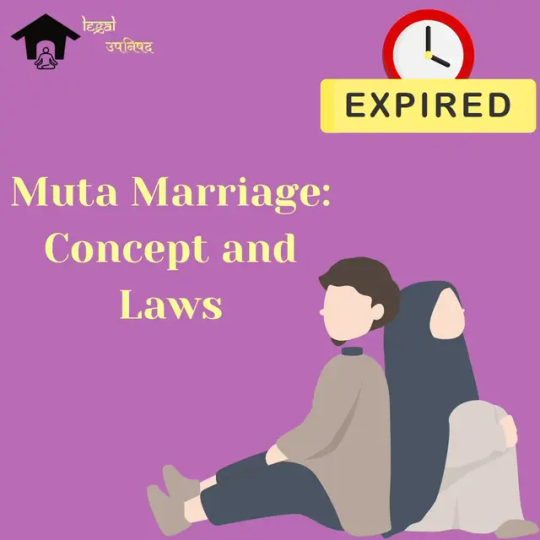
This article on 'Muta Marriage: Concept and Laws' was written by Charvi Jain, an intern at Legal Upanishad.
Introduction
The idea of muta marriage emerged in ancient times when the Arabs had to travel far from their homes for extended periods of time due to battles, pilgrimages, or commercial journeys to prevent both from engaging in prostitution and gratifying their sexual appetites. This article will focus on familiarizing the reader with the concept of Muta Marriage, its origins, and the question surrounding its legitimacy and legality in India. It will also critically analyze similar practices and the position of women participating in these marriages.
What is a Muta Marriage?
The term Muta denotes the meaning of enjoyment or pleasure. Muta marriage is entered into by a man and a woman for the sole purpose of sexual fulfillment. The time period of the marriage is decided beforehand and hence it is temporary in nature. The payment of money to the female partner is a requisite. It is recognized by Muslim Law in the Shia sect (Athna Ashria school). This type of marriage is sort of a consensual cohabitation between individuals who have attained the age of puberty. However, they should not be under a prohibited degree of relationship.
Comparative Analysis with other forms of Marriage
Unlike in other forms of marriages, the concept of divorce isn't recognized in muta marriages. The marriage can be terminated on the grounds of the death of either party or the expiry of the time period of marriage. Since it involves the concepts of compensation and deciding the terms beforehand like the duration of cohabitation, it can be referred to as a contract. Due to it being a contractual arrangement, the woman has no right to maintenance, and the two do not inherit from one another. A mu'tah union's offspring travel with the father. No extension of the mu'tah is allowed, but if a new arrangement is made with new pay for the woman, cohabitation may resume. The guidelines for mu'tah are set in stone, for instance, a temporary marriage contract can be drawn up for a time period of one hour to 99 years; it cannot be for an indefinite amount of time. This clause sets apart muta from nikah, or perpetual marriage, which has no temporal restriction. Traditional Muslim jurisprudence allows a maximum of four wives for a Muslim man to form a marital union with but in mu'tah, there is no restriction as to the number of Мu’tаh wives.
Laws surrounding the marriage
The completion of the marriage ceremony doesn't require the presence of witnesses. Both parties to a marriage have certain rights and obligations during and after the culmination of marriage. The woman is a party that has the right to lay down certain conditions and requirements e.g. Maintenance in exchange for the sexual favour provided by her to the husband. If she refuses to be intimate, then she has to return the amount of money she obtained in the form of monetary compensation. Abstinence is also required to be observed by the woman up to two menstrual cycles after the expiration of marriage. The husband reserves the right to unilaterally revoke the marriage. There are also provisions for a fixed stipulated time period for the meeting of partners and the number of sexual acts for a given period of time. The dower must be repaired. It could be considered a permanent or conventional marriage if the dower is indicated but the period is not. If the term fixed dower is not provided, the marriage is effectively void.
The legitimacy of Muta Marriage
The Sunnis which is the dominant sect of Islam, perceive muta marriage as a form of prostitution and hence is disapproved of them. However, it is considered legitimate by the Twelver Shia sect, which is predominant in Iran and constitutes 90% of India's Shia population.
Position Of Women
The males without any doubt occupy a dominant position in muta marriage which further perpetuates the gender discrimination rampant in a patriarchal society. We can turn blind eye to the fact that this marriage is indeed a form of prostitution. This temporary nature of marriage put women in a vulnerable position, subservient to the man.
Indian Scenario
The matrimonial practice of Muta is not widely prevalent in India, with Hyderabad being an exception as similar practices of temporary marriages can be seen. However, they're not enforceable in courts. There are instances of affluent men from the middle east or Arab region coming to Hyderabad to form a union in the form of muta marriage with young ladies which doesn't last long. There are several judgments concerning the regulation of muta marriages in the Indian legal system. One such judgment is Sadiq Hussain v Hashim Ali where it was that children born out of wedlock in muta marriage are legitimate and are entitled to inheritance from both parents. Additionally, as stated in the ruling in the case of Hasanali Mirza v. Nushrutali, if the cohabitation starts in the Muta but lasts longer than the time period The parties are presumed to have prolonged the term to include the entire time period, and any children born during that time will be considered legitimate. According to Shia law, a muta wife is not entitled to maintenance. However, in Luddun v. Mirza Kumar, it was determined that she was qualified for maintenance as a wife under the requirements of section 125 of the Code of Criminal Procedure, 1973.
Conclusion
In this global era, a social institution like marriage must conform to the ever-evolving ideals of society. Hence, we need to reevaluate where the practice of mu'tah fits in. There is a need for disapproval to maintain the dignity of life of women and children, which are important principles enshrined in our constitution.
References
- WHAT IS MUTA MARRIAGE AND WHAT ARE ITS CONDITIONS, available at https://www.writinglaw.com/muta-marriage-a-marriage-for-enjoyment/ (last visited on 30th December 2022). - Supra - Mu'tah, available at https://www.britannica.com/topic/mutah (last visited on 30th December,2022) - Laws related to Muslim Marriage : know more about it, available at https://blog.ipleaders.in/marriage-under-muslim-lasw/ (last visited 30th December, 2022) - Ritojit Dasgupta, "Muta Marriage- A Deep Insight", Corpus Juris The Law Journal,2582-2918, (2009). - Supra - Sadiq Hussain v Hashim Ali AIR 1916 SC 27 - Hasanali Mirza v. Nushrutali AIR 1998 SC 572 - Muta Marriage Under The Muslim Law, available at https://lawcorner.in/muta-marriage-under-the-muslim-law/ (last visited 30th December, 2022) Read the full article
0 notes
Text
5 Rights of a Married Woman in India: All You Need to Know
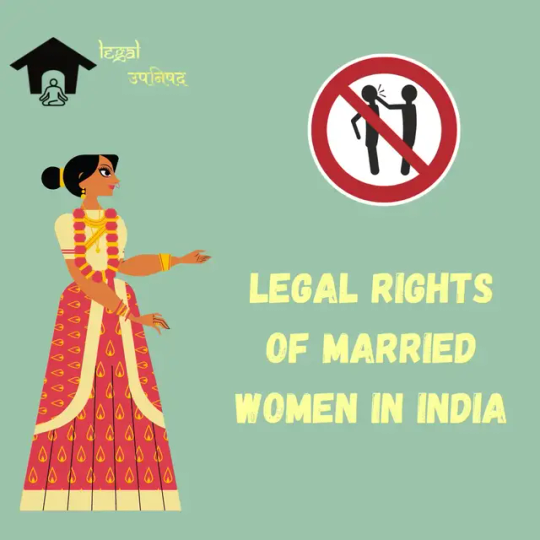
This article on 'Rights of a Married Woman in India: All You Need to Know' was published by Legal Upanishad.
Introduction
We all deserve to be treated equally without any discrimination. It is our constitutional right. Women have been treated with the maximum possible discrimination throughout history. Only a few decades ago, they were not allowed to vote, not allowed to freely express their opinion, not allowed to work. It was believed that women’s place was at home taking care of children and doing house chores. Of course, India is not immune to this discrimination. For centuries, women in India have faced extreme discrimination. They were made to stay at home, girls were not sent to school, and they faced violence at home. This article will take a look at the legal rights of a married woman in India.
Legal rights of a married woman in India
Marriage has been defined as a union between a man and a woman which is recognised by the law and by which they become husband and wife. It is also a social union between the two and their families and it also brings certain rights and duties which both need to follow. 1- Right to Streedhan 'Streedhan' is a gift in the form of property that a woman receives at the time of her marriage. This is not the same as dowry because this is a voluntary gift that can be before or after the marriage. The Courts have held that the woman has the complete right over their Streedhan even if the custody is with the husband or the in-laws. 2- Right to residence The courts have also held that a woman has the right to live or reside in the same household as her husband, it doesn't matter if the house is an ancestral homeland, a joint family or even a house that is a rental. She cannot be denied the right to live with her husband. 3- Right to a committed relationship A woman also has the right to a faithful partner. A Hindu male cannot have an affair with another girl or marry another girl while he is married. If the husband is engaged in an extramarital affair then he can be charged with adultery under section 497 of the IPC. Subsequently, the wife can file for divorce on the same grounds. 4- Right to maintenance If a Hindu wife has sought divorce from her husband on any grounds like cruelty, desertion, extramarital affair or if he has any kind of venereal disease, she can claim maintenance from the husband under section 18 of the Hindu Adoption and Maintenance Act, 1956. She can also claim permanent maintenance and alimony under section 25 of the same Act. The wife can file a petition in any court that has jurisdiction under this Act. The wife can also seek the maintenance of their minor child if she is incapable of earning herself. 5- Right against domestic violence Under the Protection of Women from Domestic Violence Act of 2005, every woman is entitled to rights against Domestic Violence. The term Domestic violence includes physical, emotional, sexual and economic abuse. In the case of domestic violence, the police are bound to register an FIR. Women are also protected under Section 498A. If they are a subject of domestic violence, the husband or anyone involved can be imprisoned for a period of up to 3 years.
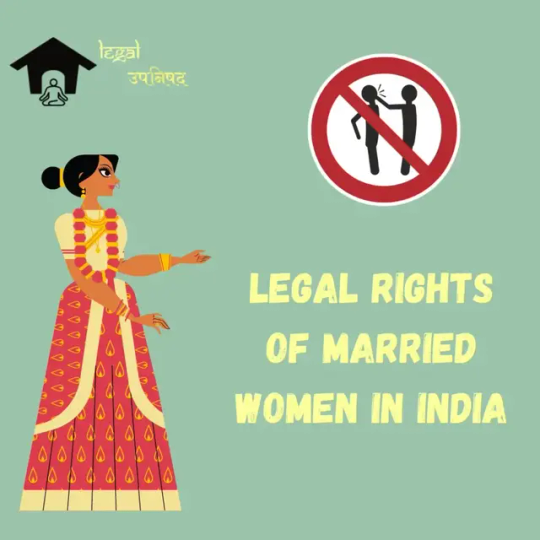
Rights of a Married Woman in India
Laws protecting the rights of a married woman in India
1- The Dowry Prohibition Act, 1961 Dowry is the exchange of goods, cash or property which is demanded from the bride’s family in exchange for money. Dowry is a cruel system because the groom’s family generally makes demands which are out of the financial capacity of the bride’s family. The family is burdened by the demands and sometimes even goes into debt to fulfil these demands. This is the reason the Parliament enacted the Dowry Prohibition Act. Section 3 of The Act states the punishment which is a minimum of 5 years of imprisonment and/or a fine of more than Rs. 15000, or the amount of the dowry, whichever is higher. This penalty is not applicable if the presents were made willfully by the bride’s parents. 3- The Commission of Sati (Prevention) Act, 1987 Sati is a barbaric system in which a widow sits on the top of the funeral pyre of her dead husband, thereby sacrificing herself. Because “she has nothing to live for after the death of her husband”. This Act was first enacted by the Government of Rajasthan. It later became an Act of Parliament of India. This Act sought to abolish the Sati system and prohibit its glorification. 4- The Protection of Women from Domestic Violence Act, 2005 Women are subject to widespread domestic violence in India. Bhartiben Bipinbhai Tamboli v. the State of Gujarat the four types of abuses mentioned are physical, sexual, emotional and economic. In the case, the court said that domestic violence in India is rampant. It doesn't matter if the woman is a wife, daughter, mother or sister, many women face domestic violence in India in several forms. Despite this, it is the least reported form of cruelty mostly because of the “social shame” attached to the word. Until 2005, the protection available was quite limited. The only remedy available was either initiating a divorce proceeding or going to the criminal court for the offence of Section 498A of the IPC. Further, extramarital affairs were not under the scope of this Act. For these reasons The Protection of Women from Domestic Violence Act, 2005 was enacted to provide a wide range of protection to women.
Conclusion
Women have been mistreated for almost the entire history of mankind all over the world, especially in India. Although The Government has enacted multiple legislations to protect the rights of a married women in India and the rights of women in general, domestic abuse still largely exists mainly because of “what will the society think”. There is an urgent need to stop thinking about what people will think of us and start thinking about ourselves and our mental and physical health.
References
- Legal Rights of a married woman in India, https://www.nrilegalservices.com/legal-rights-of-wife/#:~:text=Righttolivewithdignity,providefortheirminorchild. Accessed 26 July, 2022 - Yukta Joshi, Eight most important rights every Indian woman should know about, https://blog.ipleaders.in/eight-important-rights-every-indian-woman-know/#Right_against_domestic_violence accessed 26 July, 2022 - Srishti Kaushal, Protection of Women from Domestic Violence Act, https://blog.ipleaders.in/protection-of-women-from-domestic-violence-act/#Types_of_Abuse_covered_by_the_Act accessed 26 July, 2022 Read the full article
#LawsinIndia#RightsofaMarriedWoman#RightsofWife#womanrights#legalresearch#legalarticle#assignmenthelp#Laws
0 notes